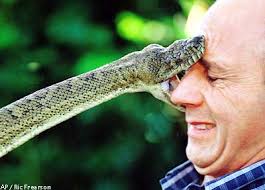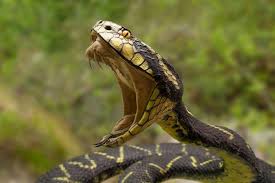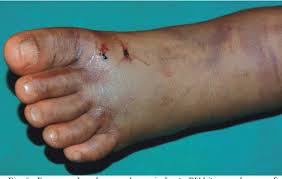Snake bites should always be taken seriously. Though some are dry bites, which aren't as dangerous and will likely cause some swelling, others are venomous bites, which, if not treated carefully and quickly, can result in death. Always seek immediate medical attention if you've been bitten by a snake, as it could be a matter of life and death.
Snakes bite either to capture prey or for self-defense. But since there are so many different types of snakes — including both venomous and non-venomous — not every snake bite is created equal.
Different species carry different types of venom. The major categories include:
- Cytotoxins: Cause swelling and tissue damage wherever you’ve been bitten.
- Haemorrhagins: Disrupt the blood vessels.
- Anti-clotting agents: Prevent the blood from clotting.
- Neurotoxins: Cause paralysis or other damage to the nervous system.
- Myotoxins: Break down muscles.
Cleveland Clinic is a non-profit academic medical center. Advertising on our site helps support our mission. We do not endorse non-Cleveland Clinic products or services.
Are snake bites dangerous?
The answer might seem obvious, but there are two different types of snake bites. And one is more serious than the other:
Dry bites: These occur when a snake doesn’t release any venom with its bite. As you’d expect, these are mostly seen with non-venomous snakes.
Venomous bites: These are much more dangerous. They occur when a snake transmits venom during a bite.
Poisonous snakes voluntarily emit venom when they bite. They can control the amount of venom they discharge, and 50 to 70% of venomous snake bites result in envenoming or poisoning. Even with a less serious type of bite, every snake bite should be treated as a medical emergency — unless you’re absolutely sure that the bite came from a non-venomous snake. Any delay in treatment following a venomous snake bite could result in serious injury or, in the worst-case scenario, death.
How common are snake bites?
Snake bites aren’t terribly common in the U.S. — and they aren’t usually fatal. But according to the World Health Organization, between 4.5 and 5.4 million snake bites occur each year and 1.8 to 2.7 million of those cause illnesses. It’s estimated that at least 81,000 to 138,000 people die each year from snake bites.
Even so it is best to treat all snake bites as a medical emergency unless one is certain the bite came from a non-venomous snake. Any delay in treatment following the bite of a venomous snake could result in death or serious injury.
Who is most at risk of suffering a snake bite?
Up to 95% of snake bites occur in either tropical or developing countries. Those who live in South Asia, Southeast Asia and sub-Saharan Africa are particularly affected by venomous snake bites, as they often don’t have access to adequate healthcare services or antivenoms. Snake bites are also especially common in poor communities, often in rural areas. People with specific jobs are also more at risk, including:
Agricultural workers.
Herders.
Fishermen.
Hunters.
In North America, most snakes are not venomous. But those that are venomous include the rattlesnake, water moccasin, coral snake and copperhead snake.
SYMPTOMS AND CAUSES
What are the symptoms of a snake bite?
If you’re bitten by a snake, your symptoms will differ depending on which type of bite it is. If you suffer a dry snake bite, you’ll likely just have swelling and redness around the area of the bite. But if you’re bitten by a venomous snake, you’ll have more widespread symptoms, which commonly include:
Bite marks on your skin. These can be puncture wounds or smaller, less recognizable marks.
Sharp, throbbing, burning pain around the bite that you may not feel for a little while after the bite. You may also feel pain all the way up whichever limb was affected, such as in the groin for a bite on the leg or the armpit for a bite on the arm. But not everyone feels pain. For example, a bite from a coral snake can be almost painless at first, but still deadly.
Redness, swelling and tissue damage, or complete destruction, in the area of the bite.
Abnormal blood clotting and bleeding. Severe bleeding can lead to a hemorrhage or kidney failure.
Low blood pressure, a faster heart rate and a weaker pulse.
Nausea and vomiting, diarrhea, anxiety, headaches, dizziness and blurred vision.
Difficulty breathing, or in serious cases, complete loss of breath.
Increased production of saliva and sweat.
Weakness in your muscles and numbness in the face or limbs.
If you have an allergic reaction to a snake bite, you could suffer from anaphylactic shock. Many of the symptoms are the same or very similar to the ones listed above, but more severe. But there are a few additional symptoms, including:
Difficulty speaking due to extreme tightness in the throat and a swollen tongue.
Young children may become very pale.
Constant cough and/or wheezing.
Which snakes are venomous?
There are two major groups of venomous snakes:
Elapids (cobra family): There are about 300 venomous species of Elapidae, including kraits, mambas, coral snakes and sea snakes. They have short fangs in the front of the upper jaw and strike downward, followed by chewing. Their venom is mainly neurotoxic but it can also harm body tissue or blood cells. If a cobra bites you, you can die from paralysis of the heart and lungs very quickly after the bite.
Vipers: There are more than 200 species of Viperidae, which includes pit vipers (like rattlesnakes, copperheads, water moccasins, or cottonmouths) and Old-World vipers (adders). They have long, hollow, venomous fangs attached to movable bones in their upper jaw. They fold their fangs back into their mouth when they’re not in use.
MANAGEMENT AND TREATMENT
How are snake bites treated?
First and foremost, seek immediate medical attention. This means call 911 or emergency services as soon as you can, because even if the bite isn’t that painful initially, you still need to treat it as if it’s potentially life-threatening. Properly identifying the snake can help with the treatment, though it’s very difficult to do so. Also be sure to take the following steps immediately:
Remove any jewelry or watches, as these could cut into the skin if swelling occurs.
Keep the area of the bite below the heart in order to slow the spread of venom through the bloodstream.
Remain still and calm. If you can, roll over to your side and rest in the recovery position. Moving around a lot will cause the venom to spread faster through the body.
Cover the bite with a clean, dry bandage. Try to use a pressure immobilization bandage if you can. This type of bandage should be tightly wrapped around the bite. Then, wrap another bandage around the entire limb, so that it’s immobilized.
While these are all useful precautionary measures, the ultimate treatment for a snake bite is antivenom. Try to get the victim of the bite antivenom as quick as possible. Knowing the size, color and shape of the snake can help your doctor determine which antivenom is best for that particular situation.
Fun fact: Antivenoms are created by immunizing horses or sheep with the venom of a particular snake. Their blood serum (the watery part of the blood) is then processed, as it will contain antibodies capable of neutralizing the effects of venom. There are antivenoms that treat bites from a specific type of snake (monospecific antivenoms) and also those that treat bites from a number of snakes found in a particular geographic region (polyspecific antivenoms).
The antivenom will be given either in an injection or through an IV (through a needle in the arm), so that it can take action as quickly as possible. While either of these methods may produce side effects, they’ve proven to be the most effective. One of those side effects is serum sickness disease, which can appear four to 10 days after receiving the antivenom. If you experience any of the following symptoms, you should contact your healthcare provider or doctor to ask about serum sickness disease:
Rashes.
Itching.
Joint pain.
Fever.
Kidney failure.
Swollen lymph nodes.
What shouldn't you do when treating a snake bite?
A snake bite can cause people to panic and act irrationally. Even so, there are certain things you should avoid doing immediately following a snake bite, including:
Don’t pick up the snake or try to wrap it up or kill it, as this will increase your chance of getting bitten again. Even dead snakes can bite.
Don’t apply a tourniquet.
Don’t cut into the wound at all.
Don’t try to suck out the venom.
Don’t apply ice or use water to submerge the wound.
Don’t drink alcohol.
Don’t drink beverages with caffeine.
Don’t take any pain-relieving medication, such as ibuprofen (Advil®, Acetaminophen®).
What happens after you're treated for a snake bite?
In most cases, you’ll need to stay in the hospital for at least 24 hours, so that doctors can monitor your blood pressure and overall health. If your blood pressure dips below a certain level, you may need IV fluids (through a needle in the arm). If the bite caused a larger-than-normal loss of blood, a blood transfusion may be necessary.
Since antivenom has potential side effects, you’ll also need to be monitored. Because of this fact, only trained medical professionals should give antivenom to patients. The amount of time it takes to completely recover depends on the kind of snake bite. In most cases, children can recover from a bite from an adder in one to two weeks. Most adults take more than three weeks, but 25% of patients need anywhere from one to nine months. Pain and swelling are common long-lasting effects in the area of the body where the bite occurred.
PREVENTION
How can you prevent a snake bite from happening?
Depending on where you live (or choose to vacation), you may or may not have a hard time avoiding snakes. But if you're going to be in snake territory, there are some useful tips to avoid getting bitten:
Always be careful where you put your hands and feet. Don’t reach into unknown spaces and holes, or underneath objects without first being sure a snake isn’t hiding underneath.
Don’t lie down or sit down in areas where there might be snakes.
Wear high-top leather boots when walking through or working in areas with dense vegetation.
Do not attempt to capture, handle or keep venomous snakes.
If you’re going camping, take extra care around swamps and other places where snakes typically live.
If you come across a snake, slowly back away from it and avoid touching it.
LIVING WITH
A note from Cleveland Clinic
If you don’t act quickly, snake bites can be incredibly dangerous, sometimes resulting in death. Though they aren’t exceedingly common in the U.S., there are still certain preventative measures you should take so that you can avoid having to deal with the complications from a venomous snake bite.












.jpeg)






0 Comments
Your comment is safe and secured